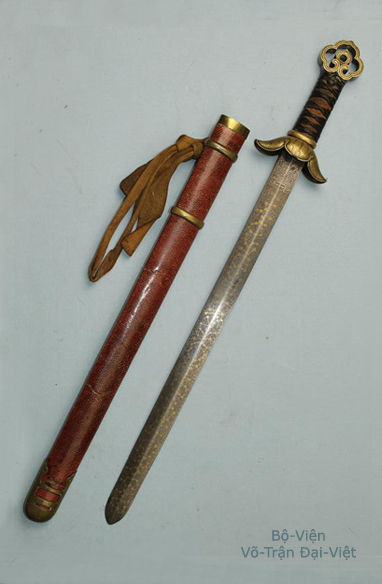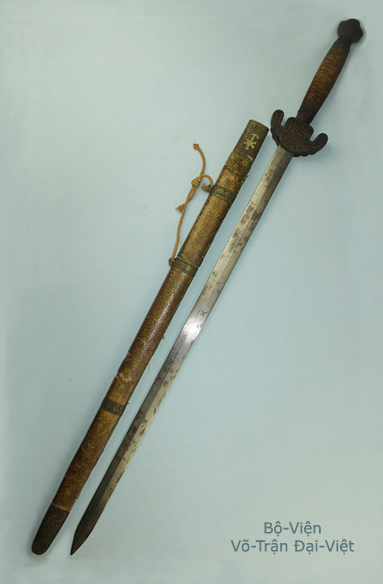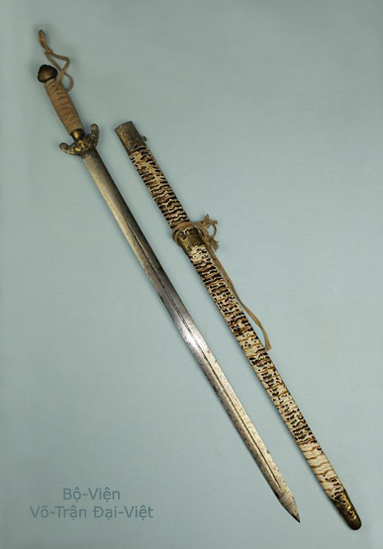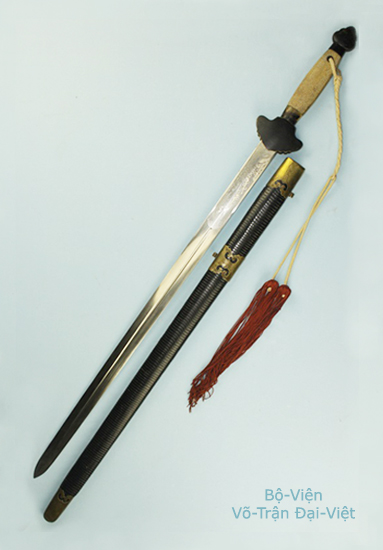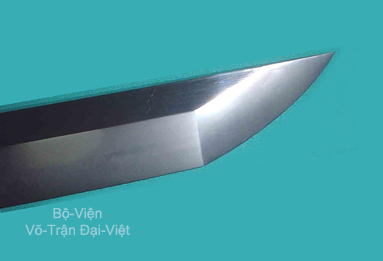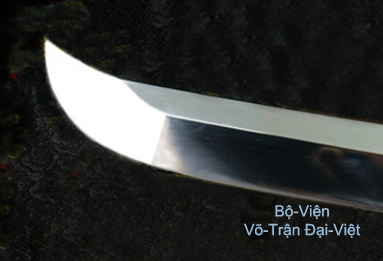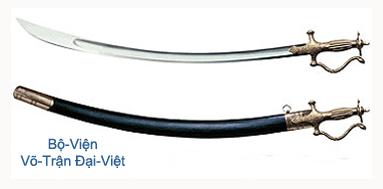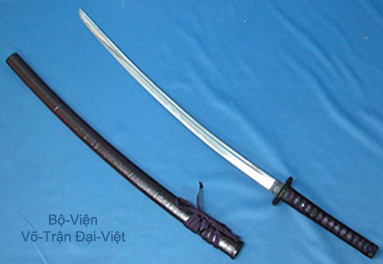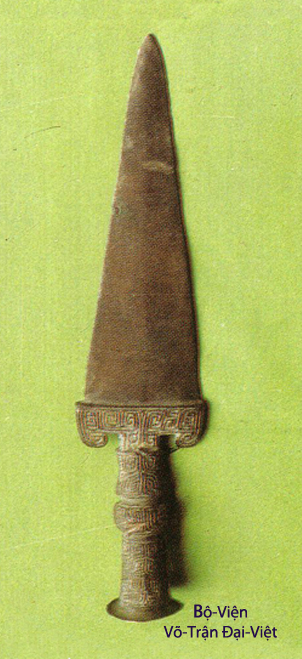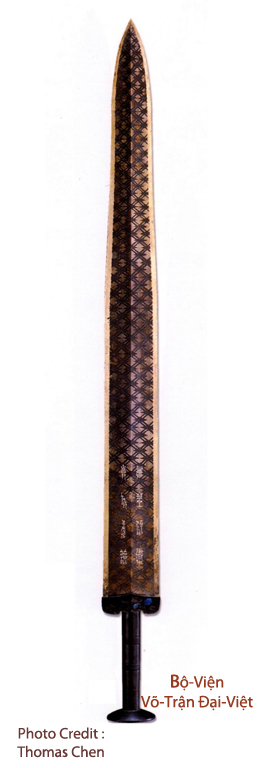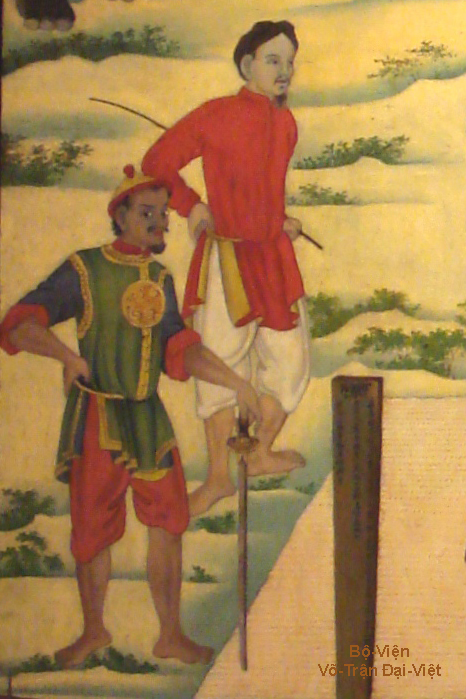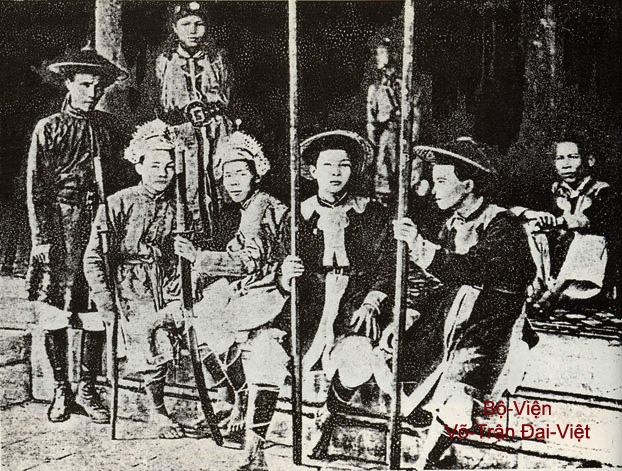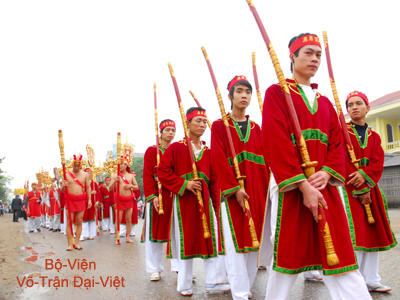II.
THE MEDIEVAL WEAPONS
2 - The Edged Arms
THE SWORD
(KIẾM - 劍)
The Sword is a weapon belonging to the Categorie of Edged Arms and that the human has the most studied with all his heart for making researches in order to forge and to temper it. And it is also a celebrious weapon from kingdom of Ngô-Việt in Spring-Autumn Period (722-481 BC).
In the book « Treaty of Researches Works - Khảo Công Ký (考 工 記) » it's quoted : « Swords from Ngô-Việt country exist in all the territory, they are at the time beautiful and excellent » « Ngô-Việt chi Kiếm, biến hồ kỳ địa, nhi phí năng lương ».
Beyond the using in war, Sword is still used as emblematic symbols :
1) - Emblematic Symbol of power in the nation ; it is there « the Precious Swoerd of du Supreme Power - Phương Thượng Bảo Kiếm » (芳 上 寶 劍 ) that the Soveraign offers to a grand mandarin for confering on him the right to "Beheading before and To Making report after - Tiền Trảm Hậu Tấu ".
2) - Emblematic Symbol of Dignity at the Court ; it is there the Sword with his Scabbard, whom ornementation and inscrutation of precious stones as well as gold and silver differ according to the nobiliary hierarchy.
3) - Emblematic Symbol in the Society ; it is there the Sword of great famillies of Letters.
4) - Emblematic Symbol of Mystic Power in the Magic ; it is there the Sword of Taoists having the power to eliminating Phantoms and to killing Devils, to making oneself invisible, to beheading at a distance.
At the Period of LÊ-Posterior Dynasty from Đại-Việt (1428~1527) and at the Period of MING Dynasty (1368~1644) from China, the sword comprises two categories, the one of Sword with a Straight Blade and the one with a Curved Blade :
1. - The Sword with Straight Blade, item available in two kinds according to the Edge :
A - Sword with Two Edges, also divided into two kinds according to the shape of the Point (called Kiếm-Phong) :
a) Sword holding Oblong shape Point, called Civil Sword Point (Văn Kiếm-Phong) ;
b) Sword holding Triangular shape Point, called Military Sword Point (Võ Kiếm-Phong).

One-Handed « Sword holding Civil Sword Point » from Civil Mandarins
( Đại-Việt - 19th century)
(Photo Credit : mandarinmansion.com)
One-Handed « Sword holding Civil Sword Point » of Taoists
|
Two-Handed « Sword holding Military Sword Point » |
In addition, this category of Sword with Two Edges are still divided into two kinds according to the length of the Sword-Bobble (Tuệ Kiếm - 彗 劍) fixed afterwards the pommel :
a) Short Sword-Bobble (Đoản-Tuệ Kiếm) ;
b) Long Sword-bobble (Trường-Tuệ Kiếm).
« Sword holding Short Sword Knot » of Taoists
|
« Sword holding Long Sword Knot » of Swordmen
|
B - Sword with Single Edge divided also into two kinds according to the shape of the Point (called Kiếm-Phong) :
a) Sword holding Straight Point (called in japanese « Chokuto - Trực-Đao 直刀 » (Straight Sabre) as the Ninja-To, specific to Japan) ;
b) Sword holding Raised Point ( Mũi Vếch - Câu Kiếm Phong 鉤 劍 鋒 - called in japanese いかり の きっさき Ikari no KIssaki). it's there the specific Sword Point to Đại-Việt « Trực-Kiếm 直 劍 » (Straight Sword).
« Straight Sword Point » from Japanese Ninja-To.
|
« Raised Sword Point » from Japanese Ikari no Kissaki Tachi.
|
2. -The Sword with Curved Blade, called sometimes Gươm (from Cantonese 劍 Gim) also divided into two kinds according to the Curvature of the Blade :
A - Sword with Curved Blade from the middle of the Blade into the Point (called in japanese Torii-Zori Tachi) ; it's there the Sword with Curved Blade of great majority of Sabres-Gươm in the world.
B - Sword with Curved Blade from the middle of the Blade into the Guard (called in japanese Koshi-Zori Tachi) ; it's there the Sword with Curved Blade specific to Japan, called « Katana ».
The renamed Sabre-Gươm « Talwar » from India. (Photo Credit : India Netzone)
|
The renamed Sabre-Gươm « Masamune Katana » from Japan. |
Synopsis of the Straight Blade Sword Category's Evolution :
The category of Sword with a Straight Blade appeared for the first time at the Eastern Zhou Dynasty 東周 Period (771~246 BC), was used as an attendant weapon and in close-combat on the war chariots. It sprang up in the antique bronze Pertuisane "Mâu" blade and bronze Dagger.
Antique Bronze Blade Pertuisane « Mâu » |
Antique Bronze Dagger |
The Eastern Zhou - Đông-CHU 東周 Dynasty Period (771~246 BC) was the stage of Swords forged in Bronze, with Two Edged Straight Blade and measure off only about 40 cm.

Two Edged Bronze Sword
Eastern- ZHOU Dynasty Period (771~246 BC)
(Photo Credit : Thomas CHEN)
In the « Spring-Autumn Period - 春 秋 時 代 » (722-481 BC) the Sword was forged in composite Bronze, with two edged straight and large blade, measuring off about 60 cm, used essentialy more for cuting than for thrusting. It is there the period of first celebrious Swords apperance in History of the Far East, forged by Âu-Dã-Tử ( 歐 冶 子 Ouye Zu) and Can-Tương (干 將 Ganjiang) from Ngô-Việt country.
« Bronze Sword » |
« Bronze Sword » of King Việt-Câu-Tiễn |
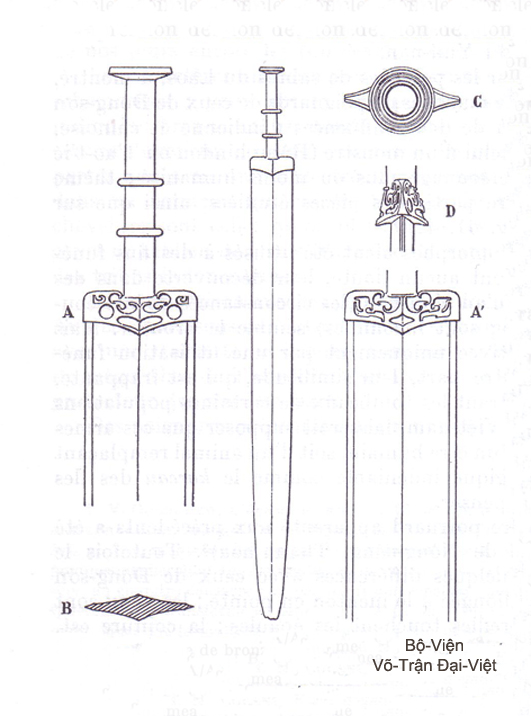
Bronze Sword (0,60 m long) with Double Edge from Đông-Sơn (Thanh-Hóa - VIỆT-NAM)
dated by B. Karlgren : 450~230 BC.
(A et A' : Hilt and both faces of the Guard ; B : Blade Section ; C : Pommel ; D :Guard in profile view.)
- Drawing of Louis Pageot, 1924. Manuel d'Archéologie d'Extrême-Orient, L. Bezacier-
In the Warring States Period, under the Tần (Qin) Dynasty (221~206 BC) the Sword was forged under the shape of Long Sword, with a two edged straight blade, narrower than the blades from « Spring-Autumn Period », handy for cuting and for thrusting at a time. The flat of the Sword blade had a losangic section with 8 angles, then reduced to 6 angles, and a length reaching untill 1,40 m. It was a historic stage historique of this category of Long Sword used with two hands, and called « Song-Thủ Kiếm - Two Handed Sword ».

Pattern of Double-Edged Long Sword, of octogonal losangic section.
QIN Dynasty (221~206 BC) period.
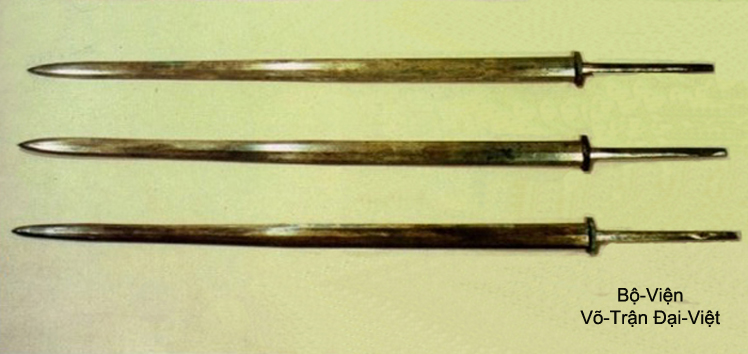
Double Edge Long Sword
QIN Dynasty Period (221~206 BC)
(Photo Credit : Thomas CHEN)
The anecdote of Emperor Tần-Thủy Hoàng-Đế (Qin Shi Huang Di (秦 始 皇 帝) (221~206 BC) of QIN, who was obliged to having someone for showing him how to turn backwards the scabbard with a view to drawing his sword, in order to defend oneself against Knight Kinh-Kha (King Ke), was precisely linked to the great length of this sword.
In the Period of Anterior-HÁN Dynasty, still called Western-HÁN Dynasty (206~9 BC), the forging art of Bronze-Tin-Chrome Alloy Swords from Tần (Qin 221~206 BC) Dynasty Period began to be perfected, and the Single-Edged Sword with a Ring Pommel was also invented.

Single-Edged Sword, called Đao, made in Bronze-Etain-Chrome Alloy,
with a Ring Pommel,
from Early HAN Dynasty Period (206~9 BC),
the first ancestor of ĐẠI-VIỆT's Single-Edged Straight Blade
and the JAPAN's Antique Sword called « Hira Zukuri Tachi ».
(Photo Credit : Thomas CHEN)
.
In the Period of Posterior-HÁN Dynasty, still called Eastern-HÁN Dynasty (23~220 AD), Swords began to be forged in Iron and Steel ; the blade having a losangic section with 8 angles, then reduce to 6 angles, finaly to 4 angles : two edged angles, called Nhận (刃) and two lateral angles, one on either side of the blade, called Tích (脊), called "Shinogi" in japanese.
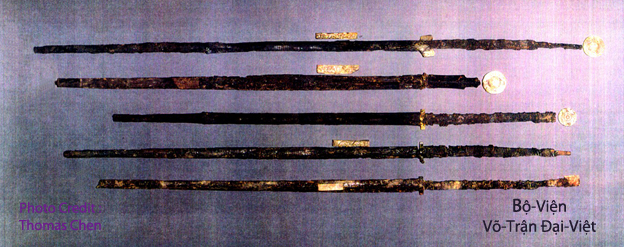
Iron-Steel Two-Edged Long Sword
Eastern-HAN Dynasty Period (23~220 AD)
(Photo Credit : Thomas CHEN)
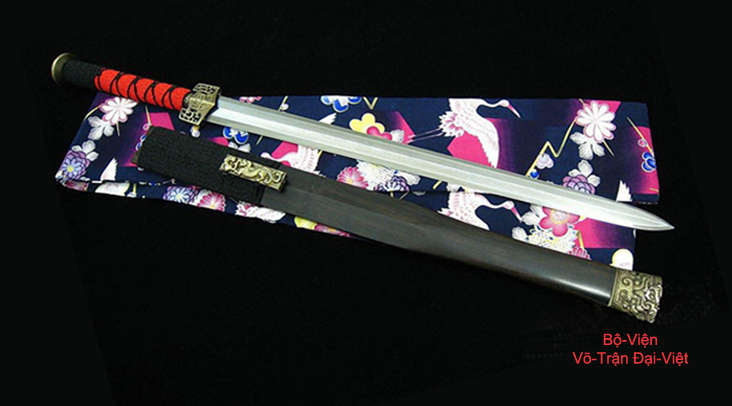
Steel forged « Two-Edged Long Sword » having Six Lateral Angles
Re-Enactment by Swords of Northshire according to
the Sword from Eastern-HAN Dynasty Period (23~220 AD)
(Photo Credit : Swords of Northshire)
Under the Tùy (Suy) Dynasty Period (581~618 AD), the art of welded Steel Swords forging from China, began to reaching the top of perfection, yielding only in front of those from Merovingians Dynasty (500~751 AD) Period in the West.

« Long Sword » in welded steel, with Two-Edged Straight Blade
from MEROVINGIENS Dynasty (500~751 JC) period in France.
(Re-Enactment by Gaël FABRE according to historic documents from BNF National Library in Paris)
(Photo Credit : Gaël FABRE)
The Sword characteristic from Tùy (Suy) Dynasty is the Single Edged Straight Blade with two lateral angles (one in each side) - called Tích ((脊) in sino-vietnamese, "Shinogi" in japanese - locating near by the edge (this Blade is called in Japan by "Kihira Zukuri") ; consequently, this Sword from Tùy (Suy) Dynasty period is very heavy.
_Kiem 01RL.jpg)
« Long Sword » in welded steel, with Single-Edge Straight Blade,
forged in 616 AD
under
SUY Dynasty Period (581~618 AD),
ancestor of Japanese Sword called « Kihira Zukuri Tachi »
(preserved at Shitenno Temple,
Osaka Prefecture, Japan).
(Photo Credit : Thomas CHEN)
Under the ĐƯỜNG (TANG) Dynasty Period (618~907 AD), the art of welded Steel Swords reached a level of perfection without precedent and inequaled afterwards in Far East, and enlarged his influence into al limitrophes countries from same culture, ie. Japan, Việt-Nam, Korea and Tibet.
It took to wait untill Yoshino Period (14th century) in Japan for that comparable precious Swords could be forged again but they belonged to the Category of Curved Blade Swords, i.e. Sabres-Gươm called « Katana, easier to forge and to temper than the one of Swords with Staight Blade from TANG Dynasty.
The characteristic of Swords in TANG Dynasty consists in a Straight Blade with Single Edge owning two lateral angles (one in each side), called Tích ((脊) - Shinogi in japanese - situated near the Blade back , i.e. : far from the edge (this Blade is called in Japan by "Shinogi Zukuri"). That's why the Blade of this Sword from TANG Dynasty period is not also heavy as the one from SUY Dynasty period and becomes easier to handle.

« Long Sword » from
TANG Dynasty Period (618~907 AD)
ancestor of the JAPAN's Sword called « Shinogi Zukuri Tachi »
and the ĐẠI-VIỆT's Sword with Raised Point (Ikari no Kissaki Tachi).
(Photo Credit : Thomas CHEN)
Later, under the ĐƯỜNG (TANG) Dynasty, another category of Sword, those of Two Edged Straight Sword was invented with an Inferior Edge (Hạ-nhận 下 刃) and a short Superior Edge (Thượng-Nhận 上 刃) or "Contre-Tranchant", located near by the point of the Sword, on the side of the back blade.

« Long Sword » with "Contre-Tranchant" from TANG Dynasty Period (618~907 AD),
ancestor of two categories of Japanese Sword called « Shinogi Zukuri Tsurugi »
and « Kissaki Moroha Zukuri Tachi - " Kogarasu Maru - 小烏丸 Tiểu Ô-Hoàn - Little Crow " ».
(Photo Credit : Thomas CHEN)
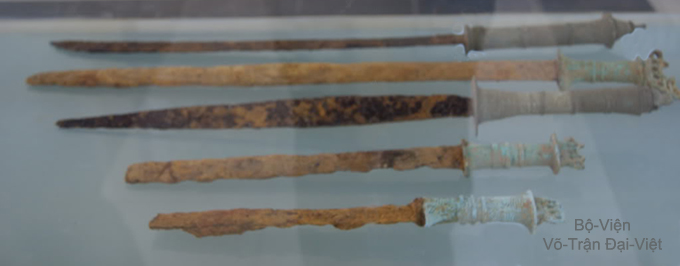
« ĐẠI-VIỆT Two-Handed and One-Handed Long Swords » holding Steel Blade
and Bronze Hilt welded to sword Guard and chased Pommel at once
(Circa 13th century)
(Photo Credit : Nguyễn Ngọc Phương Đông)
Painting of « ĐẠI-VIỆT Long Sword », holding |
« ĐẠI-VIỆT Long Sword », holding |

« Precious Sword » with Double-Edged Blade of Emperor Càn-Long (Qianlong 乾 隆 1735-1796), .
THANH (QING)
Dynasty (1644–1911).
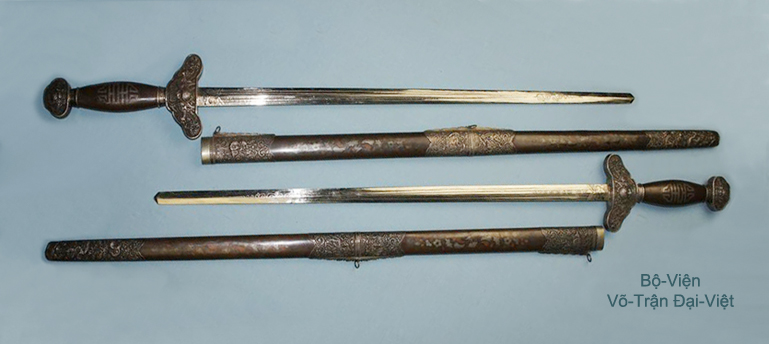
« ĐẠI-VIỆT Sword », with Double-Edged Blade.
(circa 18th ~19th century)
(Photo Credit : Gavin Nugent, swordsantiqueweapons.com)
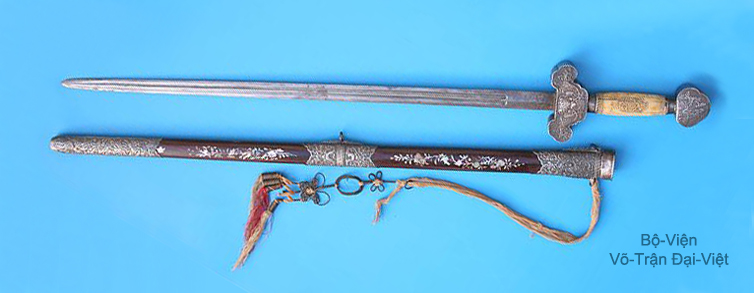
« ĐẠI-VIỆT Sword », with Double-Edged Blade.
(circa 19th century)
(Photo Credit : oriental-arms.com)
Synopsis of the Curved Blade Sword Category's Evolution :
The Category of Sword with Curved Blade, called Sabre-Gươm or Sabre-Đao, holding single edge, was appeared after the Category of Sword with Straight Blade.
The Japanese Sword « Kissaki Moroha Zukuri Tachi - "Kogarasu Maru - 小烏丸 Tiểu Ô-Hoàn - Little Crow" » with a long Inferior Edge (Hạ-nhận 下 刃) and a short Superior Edge (Thượng-Nhận 上 刃) or "False-Edge" is a piece of evidence speaking for itself of the influence of the Sword with Straight Blade from TANG Dynasty (618~907 AD).

Pattern of Japanese Long Sword (Sabre-Gươm) holding Curved Blade
« Kissaki Moroha Zukuri Tachi - "Kogarasu Maru - 小烏丸 Tiểu Ô-Hoàn - Little Crow" »
(This Sabre-Gươm having been belonged to the Emperor Kammu 781~ 806 AD).

Japanese Long Sword (Sabre-Gươm) holding Curved Blade
« Kissaki Moroha Zukuri Tachi - "Kogarasu Maru - 小烏丸 Tiểu Ô-Hoàn - Little Crow" »
(Historic Re-Enactment by Yao Yilin).
Later, this Category of Sword with Curved Blade evolved towards the Sabre-Gươm or Sabre-Đao, holding single edge. It's provides an obvious proof of the influence of the Sword with Straight Blade from TANG Dynasty (618~907 JC). and includes two kinds, the one of Two-Handed Sabre-Gươm and the one of One-Handed Sabre-Gươm :
1) The Two-Handed Sabre-Gươm :
It's the Sword with a Curved Blade (called Katana), that Japaneses have raised into the highest degree of perfection in the forge of Sword, comparable to the one from TANG Dynasty Period (618~907 JC).

Japanese Two-Handed « Sabre-Katana ».
YOSHINO Period - 14th century.

Details of Japanese Two-Handed « Sabre-Katana » Point.
YOSHINO Period - 14th century.

Two-Handed Single edged « Chinese Long Sabre », often called Miao-Dao 苗刀 - Miao's Sabre,
holding raised point,
invented by Generalissimo Thích-Kế-Quang (Qi Jiguang 1528-1587),
drawing his inspiration
from the Japanse Katana and the Raised Point Đại-Việt Sword.
In the same time, this Generalissimo invented a Treatise of 50 Fencing Lunges
teaching the wielding of this Long Sabre
for fighting
Mongolians
and Chinese South-Eastern Coast Pirates (Japanese Ronins).
(MING Dynasty - 1364~1644)

Two-Handed Bronze « Long Sabre-Gươm » from GIAO-CHÂU Land
(Photo Credit : Nguyễn Ngọc Phưong-Đông)
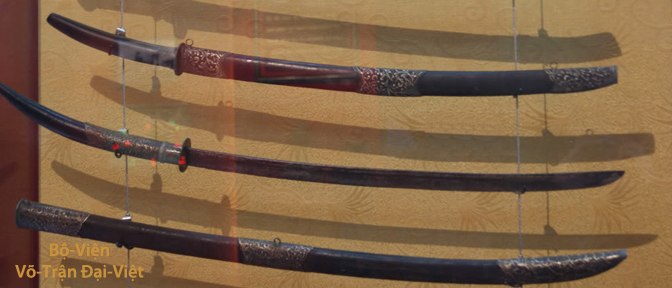
Two-Handed « Long Sabre-Gươm » of ĐẠI-VIỆT
Circa 18th~19th centuries.
( Photo credit : Nguyễn Ngọc Phưong-Đông )

Two-Handed « Long Sabre-Gươm » of ĐẠI-VIỆT
Circa 18th~19th centuries.
Imperial Guard holding the « Two-Handed Long Sabre-Gươm »
NGUYỄN Dynasty (1802-1945)
( Photo credit : Nguyễn Khắc Ngữ )
« Two-Handed Long Sabre-Gươm » during the Religious Feast (Lễ Hội)
celebrated each year on March 10th from lunar calendrar at Scarlet Temple (Đền Đỏ)
(dedicated to Holy-Mother Đạm Đồng Lương's Cult ) in
Hamlet of Sơn-Thọ,
Thái-Dương Village, District of Thái-Thụy, Nghệ-An City.
2) The One-Handed Sabre-Gươm :
It's the Sword with a Curved Blade the most usual in the world, and it's still called « Đao » in China and « Sabre » in Europe.
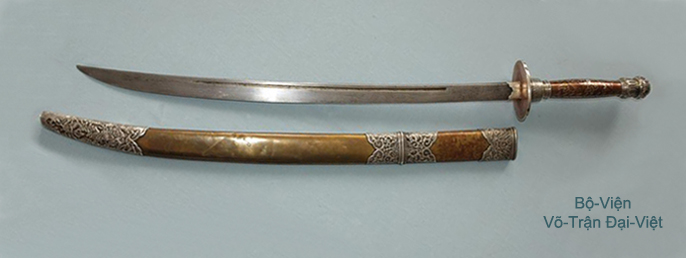
« One-Handed Sabre-Gươm » of ĐẠI-VIỆT
Đại-Việt - Circa 18th~19th centuries
(Photo Credit : Gavin Nugent, swordsantiqueweapons.com)

« One-Handed Sabre-Gươm » of ĐẠI-VIỆT
with an Inferior Edge (Hạ-nhận 下 刃) and a short Superior Edge (Thượng-Nhận 上 刃) or "Contre-Tranchant",
located near by the point of the Sword, on the side of the back blade.
Đại-Việt - Circa 18th~19th centuries
Thanh Bảo Kiếm Gươm thiêng mài sắc tự bao giờ : Kính bút,
The Precious Sword The consacred Sword has been burnished for a so long time : Best regards, |
Committee of TRỊNH Quang Thắng. |
-
Discussion about the Sword
-
Discussion about the Fencing Art
-
Discussion about the Unique Sword Wielding
Copyright © 2004 - 2019 by ACFDV - All rights reserved.
